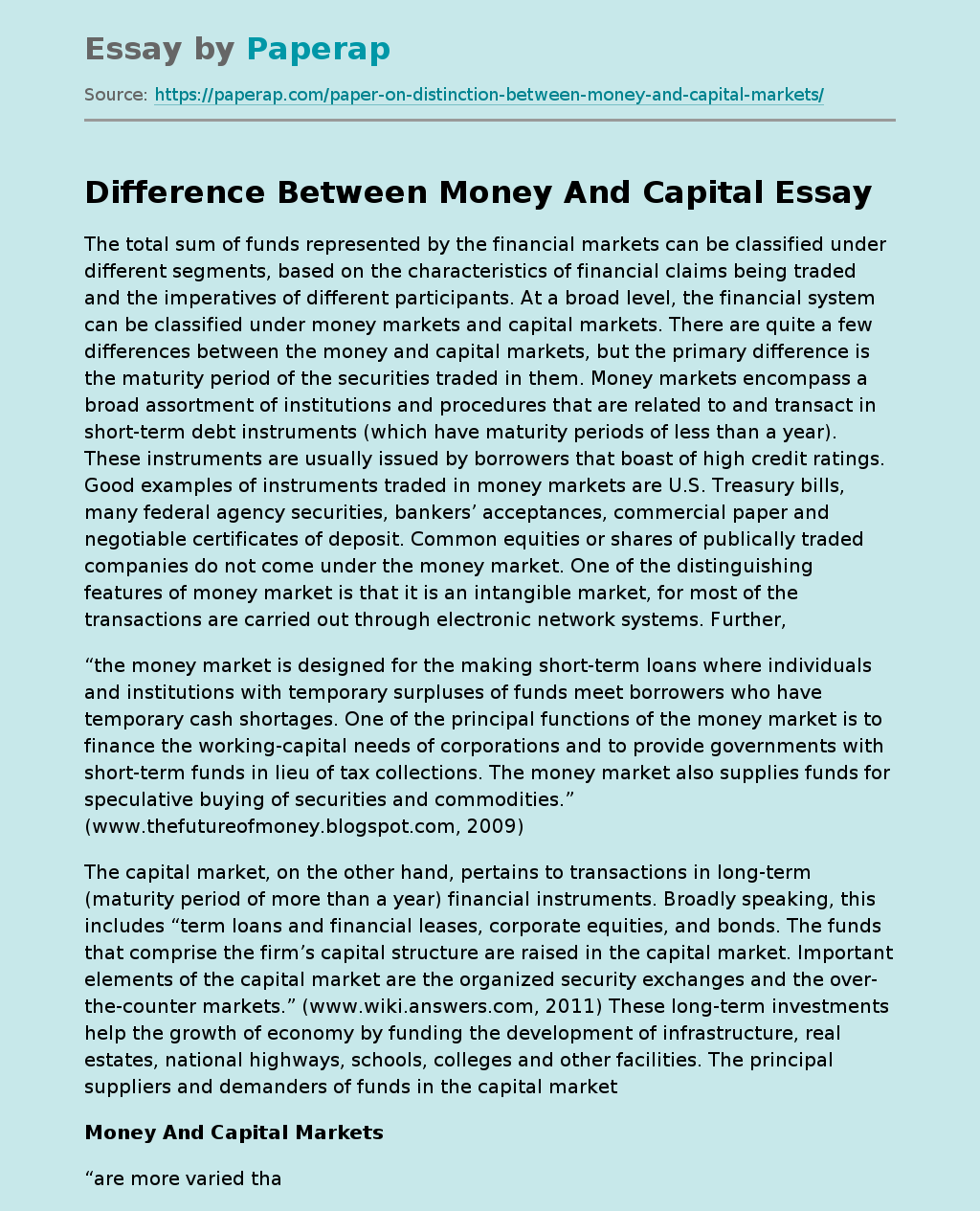Difference Between Money And Capital
The total sum of funds represented by the financial markets can be classified under different segments, based on the characteristics of financial claims being traded and the imperatives of different participants. At a broad level, the financial system can be classified under money markets and capital markets. There are quite a few differences between the money and capital markets, but the primary difference is the maturity period of the securities traded in them. Money markets encompass a broad assortment of institutions and procedures that are related to and transact in short-term debt instruments (which have maturity periods of less than a year).
These instruments are usually issued by borrowers that boast of high credit ratings. Good examples of instruments traded in money markets are U.S. Treasury bills, many federal agency securities, bankers’ acceptances, commercial paper and negotiable certificates of deposit. Common equities or shares of publically traded companies do not come under the money market. One of the distinguishing features of money market is that it is an intangible market, for most of the transactions are carried out through electronic network systems.
Further,
“the money market is designed for the making short-term loans where individuals and institutions with temporary surpluses of funds meet borrowers who have temporary cash shortages. One of the principal functions of the money market is to finance the working-capital needs of corporations and to provide governments with short-term funds in lieu of tax collections. The money market also supplies funds for speculative buying of securities and commodities.
” (www.thefutureofmoney.blogspot.com, 2009)
The capital market, on the other hand, pertains to transactions in long-term (maturity period of more than a year) financial instruments. Broadly speaking, this includes “term loans and financial leases, corporate equities, and bonds. The funds that comprise the firm’s capital structure are raised in the capital market. Important elements of the capital market are the organized security exchanges and the over-the-counter markets.” (www.wiki.answers.com, 2011) These long-term investments help the growth of economy by funding the development of infrastructure, real estates, national highways, schools, colleges and other facilities. The principal suppliers and demanders of funds in the capital market
Money And Capital Markets
“are more varied than in the money. An institution must be large and well known with an excellent credit rating to gain access to the money market. The capital market for long-term funds, in contrast, encompasses both well-established and lesser-known individuals and institutions. Families and individuals, for example, tap the capital market when they borrow to finance a new home or new automobile. State and local governments rely upon the capital market for funds to build schools, highways, and public buildings and to provide essential services to the public.” (www.thefutureofmoney.blogspot.com, 2009)
Coming back to the money market, commercial banking institutions play a key role in lending to the business and public sector. The U.S. Treasury is the biggest borrower in the money market, while large business corporations also actively participate in it. Since large securities dealers need sufficient amount of liquidity to carry out their daily operations, they also borrow from money markets. The Federal Reserve is another major financial institution serves as both the lender and borrower in order to regulate and stabilize the financial system.
Works Cited:
Difference between money and capital markets, retrieved from
on 10th July, 2011
The future of Money Blog, Money Market versus the Capital Market, Friday, September 25, 2009, retrieved from
on 10th July, 2011
The total sum of funds represented by the financial markets can be classified under different segments, based on the characteristics of financial claims being traded and the imperatives of different participants. At a broad level, the financial system can be classified under money markets and capital markets. There are quite a few differences between the money and capital markets, but the primary difference is the maturity period of the securities traded in them. Money markets encompass a broad assortment of institutions and procedures that are related to and transact in short-term debt instruments (which have maturity periods of less than a year). These instruments are usually issued by borrowers that boast of high credit ratings. Good examples of instruments traded in money markets are U.S. Treasury bills, many federal agency securities, bankers’ acceptances, commercial paper and negotiable certificates of deposit. Common equities or shares of publically traded companies do not .
Difference Between Money And Capital. (2019, Dec 05). Retrieved from https://paperap.com/paper-on-distinction-between-money-and-capital-markets/

